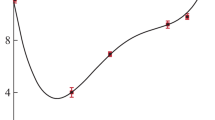Abstract
In this paper, viscose rayon-based knitted fabrics were utilized as the precursor to produce activated carbon fiber absorbents (ACFA). The effects of carbonization and activation conditions on characteristics (ACFA) were examined. Experimental results revealed that increasing the flow rate of environmental gas N2 and steam activator used in conjunction and decreasing the production rate of ACFA can obtain better pore properties. However, higher flow rate of steam activator and lower production rate of ACFA reduced the weight yield. According to our findings, to maintain good absorption property of ACFA, the optimum manufacturing conditions are flow rate of gas N2 at 80 cc/min, flow rate of steam activator at 60 ml/min, and production rate of ACFA at 30 cm/min, with flame retardant reagent concentration maintained at 30%. Under these conditions, the weight yield can be up to 40.85% and the BET surface area can exceed 1500 g/m2.
Similar content being viewed by others
References
W. F. Abbott,U.S. Patent, 3179605 (1965).
W. Watt and B. V. Perov, “Handbook of Composites”, Vol. 1, pp.327–387, Elsevier Science Publishers B.V., North-Holland, 1985.
J. B. Parra, J. C. De Sousa, J. J. Pis, J. A. Pajares, and R. C. Bansal,Carbon,33, 801 (1995).
S. F. Grebennikov and L. I. Fridman,Fiber Chem.,19, 385 (1987).
J. D. de López-González, F. Martínez-Vilchez, and F. Rodríguez-Reinoso,Carbon,18, 413 (1980).
S. Lowell and J. E. Shields, “Powder Surface Area and Porosity”, p.22, Chapman and Hall Pub., USA, 1984.
R. Nacco and E. Aquarone,Carbon,16, 31 (1978).
F. Rodríguez-Reinoso and M. Molina-Sabio,Carbon,30, 1111 (1992).
R. Torregrosa and J. M. Martín-Martínez,Fuel,70, 1173 (1991).
J. Alcañiz-Monge, D. Cazorla-Amorós, A. Linares-Solano, S. Yoshida, and A. Oya,Carbon,32, 1277 (1994).
C. H. Wang,U. S. Patent, 5819350 (1998).
ASTM D5035-95, “Standard Test Method for Breaking Force and Elongation of Textile Fabrics (Strip Method)”, American Society for Testing and Materials, 2003.
ASTM D1388-96, “Standard Test Method for Stiffness of Fabrics”, American Society for Testing and Materials, 2002.
ASTM D1776-98, “Standard Practice for Condition and Testing Textiles”, American Society for Testing and Materials, 2003.
S. J. Greeg and K. S. W. Sing, “Absorption, Surface Areas and Porosity”, pp.42–54, Academic Press, London, New York, 1982.
S. Brunauer, P. H. Emmett, and E. Teller,J. Am. Chem. Soc.,60, 309 (1938).
S. Brunauer, L. S. Deming, W. E. Deming, and E. Teller,J. Am. Chem. Soc.,62, 1723 (1940).
Author information
Authors and Affiliations
Corresponding author
Rights and permissions
About this article
Cite this article
Su, CI., Wang, CL. Optimum manufacturing conditions of activated carbon fiber absorbents. II. Effect of carbonization and activation conditions. Fibers Polym 8, 482–486 (2007). https://doi.org/10.1007/BF02875869
Received:
Revised:
Accepted:
Issue Date:
DOI: https://doi.org/10.1007/BF02875869



